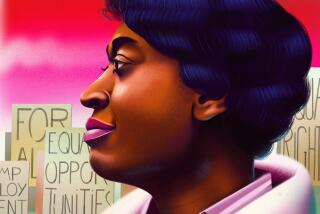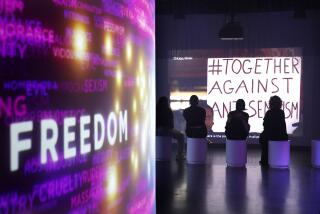A Three-Day Assault on Skinheads’ Hatred : Prejudice: Members of group are confronted with prisoners, the Holocaust and a judge. Some remain defiant.
Renee Firestone, a survivor of the Holocaust that claimed the lives of her mother and father, looked out into a circle of 13 white faces Thursday evening and shuddered.
“Why are you so angry?” she asked the young members of the Fourth Reich Skinheads. “I have a reason to be angry. . . . What is your reason?”
The skinheads listed one grievance after another: minorities who they said had beaten and robbed them, and reporters who they felt had misrepresented them.
“The odds are totally against us,” one of the young people said. “I give everybody a chance until they screw me over.”
That session--a meeting between self-described racists and two Holocaust survivors who have devoted much of their lives to battling hatred--was the culmination of an extraordinary program designed to force members of the Fourth Reich Skinheads to confront the causes and consequences of racism.
During three sometimes volatile, sometimes emotional days, the members of the skinheads also went to a jail, met a federal judge, saw the movie “Schindler’s List,” toured the Simon Wiesenthal Center’s Museum of Tolerance and shared a tearful exchange with a prominent South Los Angeles preacher whom some of them had plotted to kill.
The chief architect of that program, Assistant U.S. Atty. Marc R. Greenberg, had successfully negotiated guilty pleas for two of the Fourth Reich Skinheads who were charged with carrying out bombings and plotting an attack on the First African Methodist Episcopal Church. But Greenberg wanted more than convictions.
Instead, he launched a campaign to educate, if not reform, the defendants and the other skinheads. Dubbing the effort Operation Grow Hair, he brought together several prominent local organizations, including the First AME Church, the Martin Luther King Dispute Resolution Center, the American Jewish Committee and the Simon Wiesenthal Center. Their mission: to steer the skinheads away from anger so intense that it had driven some of them to hatch plans for launching a race war.
“History is full of examples of people who changed the directions of their lives,” said Rabbi Marvin Hier, dean of the Wiesenthal Center. “It’s worth a shot.”
*
The arrests of three Fourth Reich Skinheads in July shook Southern California. These were not extremist punks with shaved heads in countries far away, but home-grown suburbanites with expertise in pipe bombs and dreams of assassinating Rodney G. King, Jewish leaders and the Rev. Cecil Murray of the First AME Church.
Organizers of the counseling program were not naive. They knew what they are up against, that the hate in some of these young adults runs deep. The skinheads’ own words, captured by the FBI on secret audio and videotapes, are proof of that.
The skinheads talked hopefully, for example, about the prospects of igniting a race war, rattling off the names of prominent blacks they would like to see dead, according to previously undisclosed transcripts of the tapes. Two young men played particularly prominent roles, Christopher David Fisher, 20, and Carl Daniel Boese, 17. Both would later plead guilty to conspiracy.
It was Fisher and Boese who hatched the plan to attack First AME Church, according to the transcripts. On June 11, they shared their proposal with other members of the group.
“Have any of you guys heard of the African Methodist Episcopalian Church?” Boese asked at that meeting. “It’s the one where like when the Rodney King verdict was announced, they showed all those niggers hopping up and down.”
Boese and Fisher described their plans for the attack, which involved killing Murray and strafing the congregation with gunfire. “I mean, you’re just gonna be mowing down basically everything in front of you,” Fisher said at one point. “And also I think pipe bombs in the way of grenades. You sit there and toss ‘em into the middle of the pews . . . people are running everywhere . . . havoc, and you know exactly what you’re doing and where you’re going, and you get the ---- out. That’s it.”
By July, Fisher and Boese also were preparing attacks on synagogues and Jewish leaders. Fisher had just one condition: that his pipe bombs not be used unless people would be hurt.
“I don’t wanna put it on an empty building because if you blew up a--say, a synagogue--dude, yeah, it’s gonna do damage, but nobody’s gonna get hurt and (the) message won’t be sent,” Fisher said. “That’s a waste of a pipe bomb, I think.”
Although the skinheads would say they were entrapped by the FBI, the transcripts reveal that the FBI undercover agent and informant repeatedly urged them not to take violent action. Nevertheless, by mid-July prosecutors and investigators were concerned that they could no longer keep a lid on the group. Fisher, Boese and a third skinhead were arrested July 15.
*
The counseling for the Fourth Reich Skinheads began at 9 a.m. Tuesday morning when they shuffled into the courtroom of U.S. District Judge Terry J. Hatter Jr., one of the most respected and outspoken members of the federal bench in Los Angeles. Hatter, who is black, donned his robes for the occasion. He stared down from the bench at Fisher, Boese and the seven other young men and four young women slouched on the courtroom benches, some decked out in jeans and Doc Marten boots.
One by one, Hatter called the participants to the lectern asking them their names, their ages and their aspirations. The first was chewing gum, one of Hatter’s pet peeves. When the judge asked him whether he had gum in his mouth, the youngster quickly swallowed it and said no.
As they stood before the judge, a few apologized for the racism and hatred they had expressed. They talked of wanting to go to college, of getting on with their lives.
But a couple of the skinheads were openly unrepentant. They told Hatter they felt minorities were given unfair advantages in school--allowed to celebrate Black History Month, for instance, when no comparable commemoration was set aside for whites. They complained that when they questioned those practices, they were shouted down. Hatter listened, asked them about their views, drew them out a bit, but could not convince them to reconsider.
“At least I felt they were being honest,” the judge said.
*
After their talk with Hatter, the skinheads were ferried by program officials to the Los Angeles County Men’s Central Jail. On the way, a few boasted that they were undeterred by Hatter’s warnings.
But for some at least, the bravado melted behind bars. Lt. Mark Milburn, a 23-year veteran of the Sheriff’s Department, walked them through a cellblock, showing them the steel shanks that prisoners make to cut each other while informing them of the monotonous and frightening life of an inmate.
“Only you can change where you’re headed,” Milburn said he told the teen-agers. “If you don’t want to be back as inmates instead of visitors, you better make that change.”
The skinheads asked few questions, even when given the chance to speak to two black gang members and a white inmate with past ties to a white supremacist group. But one of those sessions hit a riveting snag when a skinhead absent-mindedly cracked his knuckles--unbeknown to him, a jail sign of disrespect, of raising a challenge.
The inmate, a 26-year-old who killed seven people and expects to spend the rest of his life in prison, wheeled on the teen-ager, participants said later.
“Are you calling me out? Let’s go,” the inmate reportedly said, staring directly at the skinhead. “Maybe you think you’re bad when you are three or four or five of you together, but that’s not the way it is in here. In here, you’d be my bitch.”
The teen-ager went pale. He did not crack his knuckles again.
“I’ve never been so scared in my life, and I’ve been in some pretty hairy situations,” one of the skinheads confided later. “I will never break the law after that.”
The inmates, however, were not convinced. After they wrapped up their sessions, they spoke individually with deputies. All of the inmates said they saw two or three of the skinheads who had the look of people who would be back.
*
If the trips to the jail and to a later viewing of Steven Spielberg’s Holocaust film, “Schindler’s List,” had startled the skinheads Tuesday, they seemed to be unaffected by the next morning.
They were scheduled to spend the day at Chapman University in Orange County, where a group of students from the American Jewish Committee’s Hands Across the Campus program were to join them for exercises intended to prompt discussion about diversity and racism. When one of those students, a soft-spoken teen-ager named Francisco Flores Mendieta, arrived to begin the session, the skinheads caught sight of him and wanted to call the whole thing off.
“They thought he was a gang member,” said Michael Matsuda, the director of student leadership training for Hands Across the Campus who spent the entire three days with the skinheads.
Eventually, the skinheads relented and allowed the other young people to join them. Participants on both sides were wary: Some in each group used false names so that their counterparts would not know who they were.
As they talked, the skinheads at first vehemently denied that they were anything but a well-intentioned bunch. One said the Fourth Reich Skinheads really had wanted to do community projects such as cleaning up parks. The group’s name, they said, was chosen to intimidate. They had a harder time explaining why intimidation was necessary for cleaning up parks.
The fragile harmony broke down after a few of the skinheads began deriding Jews as a race inferior to Aryan whites. That enraged some of the Hands Across the Campus students, and by day’s end, both groups were arguing vociferously.
Many of the students from Hands Across the Campus considered the skinheads ignorant and racist. The skinheads saw themselves as smarter than their counterparts. “We absolutely slaughtered them when it comes to proving who’s right or wrong,” one skinhead later boasted.
Near the end of the day, Matsuda posed a question: “Are we all equal?”
Members of Hands Across the Campus nodded. Several of the skinheads shook their heads, signaling no.
“It was a long day,” said Chris Wallace, one of the Hands Across the Campus students. “A very long day.”
*
The program’s final day brought together for the first time the skinheads and some of those they had prided themselves on hating. Meeting at the Simon Wiesenthal Center in West Los Angeles, one group of skinheads gathered with rabbis while another sat down with Murray and other leaders of the First AME Church.
Both sides emerged from those sessions with glimmers of hope.
When some of the skinheads told Rabbi Daniel Landes that they believed kosher foods were tainted or were intended to mark up prices and raise money for Jewish causes, Landes patiently explained the real history of kosher. When the skinheads defended their fear of other races, Landes pointed out the fear they themselves had instilled.
The teen-agers came away impressed, both by the rabbi’s answers and by his willingness to talk to them as intelligent adults.
In another room a few feet away, the program reached its emotional climax as Murray, Chris Fisher and Dan Boese all met. Fisher and Murray had exchanged letters, but until Thursday, the young men and their intended assassination target had never looked each other in the eye.
Murray shook Fisher’s hand and sat next to him at the table. At first the session was strained, but as the conversation moved around the group, participants say the talk loosened. Boese told a story that he believed explained his racism. At a very young age, Boese reportedly told the other members of the group, he had been ousted from a sandbox by a person of another race.
Murray nodded, and then told a story of his own. He said that when he finished serving in the Air Force during World War II, he came home to Florida with medals and an expectation that he would be treated with respect. Instead, he reportedly said, white people spat on him. With that, Murray and Boese began to cry. Fisher, also sitting at the table, cried as well.
“The hardened attitudes softened,” Murray said. “I believe we understood each other.”
*
Si Frumkin, 63, spent three years in a Lithuanian ghetto and another 1 1/2 years at the Dachau concentration camp. His father died there. Firestone, 69, survived the death camp at Auschwitz. Her mother and sister did not. Her father was forced on a death march by the Nazis, and he too died shortly afterward.
Frumkin and Firestone have devoted much of their lives to teaching about the Holocaust. They both have confronted doubters, but they are persistent, and they are determined to confront evil. When they were asked by the Wiesenthal Center to speak to the Fourth Reich Skinheads, they agreed without hesitation.
“Most survivors, including myself, were silent for a long time,” Firestone said. “Not much has changed in the world. I feel somewhat responsible.”
Some of these same young skinheads whom Firestone and Frumkin confronted Thursday had lobbed Molotov cocktails at synagogues and prepared mail bombs to send to rabbis. At least one had scrawled the words “Die Jew Pig” on the wall of a Westminister synagogue and had then boasted about it afterward.
From behind a lectern, the Holocaust survivors told the skinheads of their experiences during World War II, of ghettos and concentration camps, of the lives lost to hatred. Frumkin brought a photo of his granddaughter, and he asked the skinheads how they could possibly hate a little girl they had never met.
The reaction from the skinheads was fierce at first. They angrily denied that they were neo-Nazis and accused Frumkin and Firestone of falsely accusing them. Boese insisted that “judging people by their groups is inescapable,” even as other youngsters lambasted Frumkin and Firestone for judging them as a group.
The two survivors took the attack in stride, however, and as they left, several of the skinheads took their hands and thanked them for coming. One girl hugged Firestone.
Frumkin’s only regret was that he could not do more.
“I wanted to have a group of them to my house for dinner,” Frumkin said, “to show them that we don’t drink Christian blood. It’s tomato juice. . . . I am not what they think I am. I am only me. I am a human being, I am a father. I am a grandfather. They have no reason to hate me.”
*
Did the program reach the young skinheads? Did it talk them out of racism, or at least convince them not to act out on their hatred?
“You can’t change a human being overnight,” Firestone said. “But I think they learned something.”
The skinheads agreed. Nearly half the group said they would like to return to work with the counselors more often, perhaps to engage in community service. Without exception, those skinheads who would talk to reporters said they would do anything to keep from going back to jail.
“I don’t ever want to go there again,” one girl said. “I’m not eating that food. I’m not smelling that smell. I’m not living with those people.”
But racism is a stubborn thing, and few of the skinheads were ready to give it up.
“Whites are getting an absolute kick in the ass,” one said as he sipped a soda and reflected on the three days of counseling. “I’ll be racist as long as that’s the case.”
And another, while praising the program and saying that it had deeply affected his thoughts on some issues, still had one lingering question: “If black people are so interested in their heritage,” he asked at the end of the program, “why don’t they move back to Africa?”
More to Read
Sign up for Essential California
The most important California stories and recommendations in your inbox every morning.
You may occasionally receive promotional content from the Los Angeles Times.










